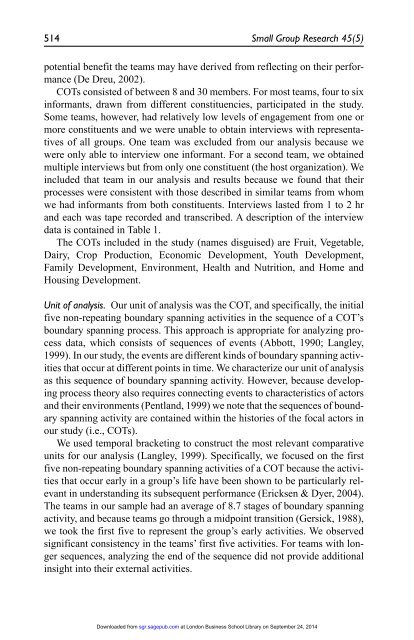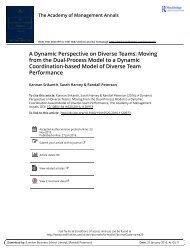The Process of Team Boundary Spanning in Multi-Organizational Contexts - Sarah Harvey, Randall S. Peterson, and N. Anand
Work teams must increasingly operate in complex environments characterized by multiple external actors beyond team and organizational boundaries. Although previous research demonstrates the importance of boundary spanning activities to team effectiveness, it reveals relatively little about the process of boundary spanning in these environments. In this article, we investigated the processes of boundary spanning across multiple external actors in 10 cross-organizational teams. We identified three sequences for reaching out to external actors: (a) moving inside-out from vertical actors inside the host organization to horizontal actors outside of the host organization, (b) moving outside-in from horizontal actors to vertical, and (c) staying-inside with vertical actors from the host organization. Our observations suggest that inside-out and outside-in sequences were more successful than simply pleasing the host organization. We build on our empirical findings to develop a process theory of how team boundary spanning activities across multiple external actors influence team effectiveness. Our research underscores the importance of a team’s interactions with actors in its external environment beyond those in an immediate supervisory role and provides insight into the dynamics of boundary spanning in multi-organizational contexts.
Work teams must increasingly operate in complex environments
characterized by multiple external actors beyond team and organizational
boundaries. Although previous research demonstrates the importance of
boundary spanning activities to team effectiveness, it reveals relatively little
about the process of boundary spanning in these environments. In this article,
we investigated the processes of boundary spanning across multiple external
actors in 10 cross-organizational teams. We identified three sequences for
reaching out to external actors: (a) moving inside-out from vertical actors inside
the host organization to horizontal actors outside of the host organization,
(b) moving outside-in from horizontal actors to vertical, and (c) staying-inside
with vertical actors from the host organization. Our observations suggest
that inside-out and outside-in sequences were more successful than simply
pleasing the host organization. We build on our empirical findings to develop
a process theory of how team boundary spanning activities across multiple
external actors influence team effectiveness. Our research underscores the
importance of a team’s interactions with actors in its external environment beyond those in an immediate supervisory role and provides insight into the
dynamics of boundary spanning in multi-organizational contexts.
You also want an ePaper? Increase the reach of your titles
YUMPU automatically turns print PDFs into web optimized ePapers that Google loves.
514 Small Group Research 45(5)<br />
potential benefit the teams may have derived from reflect<strong>in</strong>g on their performance<br />
(De Dreu, 2002).<br />
COTs consisted <strong>of</strong> between 8 <strong>and</strong> 30 members. For most teams, four to six<br />
<strong>in</strong>formants, drawn from different constituencies, participated <strong>in</strong> the study.<br />
Some teams, however, had relatively low levels <strong>of</strong> engagement from one or<br />
more constituents <strong>and</strong> we were unable to obta<strong>in</strong> <strong>in</strong>terviews with representatives<br />
<strong>of</strong> all groups. One team was excluded from our analysis because we<br />
were only able to <strong>in</strong>terview one <strong>in</strong>formant. For a second team, we obta<strong>in</strong>ed<br />
multiple <strong>in</strong>terviews but from only one constituent (the host organization). We<br />
<strong>in</strong>cluded that team <strong>in</strong> our analysis <strong>and</strong> results because we found that their<br />
processes were consistent with those described <strong>in</strong> similar teams from whom<br />
we had <strong>in</strong>formants from both constituents. Interviews lasted from 1 to 2 hr<br />
<strong>and</strong> each was tape recorded <strong>and</strong> transcribed. A description <strong>of</strong> the <strong>in</strong>terview<br />
data is conta<strong>in</strong>ed <strong>in</strong> Table 1.<br />
<strong>The</strong> COTs <strong>in</strong>cluded <strong>in</strong> the study (names disguised) are Fruit, Vegetable,<br />
Dairy, Crop Production, Economic Development, Youth Development,<br />
Family Development, Environment, Health <strong>and</strong> Nutrition, <strong>and</strong> Home <strong>and</strong><br />
Hous<strong>in</strong>g Development.<br />
Unit <strong>of</strong> analysis. Our unit <strong>of</strong> analysis was the COT, <strong>and</strong> specifically, the <strong>in</strong>itial<br />
five non-repeat<strong>in</strong>g boundary spann<strong>in</strong>g activities <strong>in</strong> the sequence <strong>of</strong> a COT’s<br />
boundary spann<strong>in</strong>g process. This approach is appropriate for analyz<strong>in</strong>g process<br />
data, which consists <strong>of</strong> sequences <strong>of</strong> events (Abbott, 1990; Langley,<br />
1999). In our study, the events are different k<strong>in</strong>ds <strong>of</strong> boundary spann<strong>in</strong>g activities<br />
that occur at different po<strong>in</strong>ts <strong>in</strong> time. We characterize our unit <strong>of</strong> analysis<br />
as this sequence <strong>of</strong> boundary spann<strong>in</strong>g activity. However, because develop<strong>in</strong>g<br />
process theory also requires connect<strong>in</strong>g events to characteristics <strong>of</strong> actors<br />
<strong>and</strong> their environments (Pentl<strong>and</strong>, 1999) we note that the sequences <strong>of</strong> boundary<br />
spann<strong>in</strong>g activity are conta<strong>in</strong>ed with<strong>in</strong> the histories <strong>of</strong> the focal actors <strong>in</strong><br />
our study (i.e., COTs).<br />
We used temporal bracket<strong>in</strong>g to construct the most relevant comparative<br />
units for our analysis (Langley, 1999). Specifically, we focused on the first<br />
five non-repeat<strong>in</strong>g boundary spann<strong>in</strong>g activities <strong>of</strong> a COT because the activities<br />
that occur early <strong>in</strong> a group’s life have been shown to be particularly relevant<br />
<strong>in</strong> underst<strong>and</strong><strong>in</strong>g its subsequent performance (Ericksen & Dyer, 2004).<br />
<strong>The</strong> teams <strong>in</strong> our sample had an average <strong>of</strong> 8.7 stages <strong>of</strong> boundary spann<strong>in</strong>g<br />
activity, <strong>and</strong> because teams go through a midpo<strong>in</strong>t transition (Gersick, 1988),<br />
we took the first five to represent the group’s early activities. We observed<br />
significant consistency <strong>in</strong> the teams’ first five activities. For teams with longer<br />
sequences, analyz<strong>in</strong>g the end <strong>of</strong> the sequence did not provide additional<br />
<strong>in</strong>sight <strong>in</strong>to their external activities.<br />
Downloaded from sgr.sagepub.com at London Bus<strong>in</strong>ess School Library on September 24, 2014
















